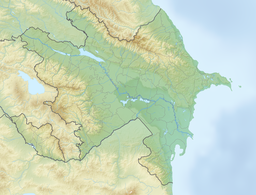Shamkirchay reservoir
| Shamkirchay reservoir | |
|---|---|
 Shamkirchay reservoir | |
| Location | Shamkir District |
| Coordinates | 40°40′47″N 46°01′45″E / 40.67972°N 46.02917°E |
| Type | reservoir |
| Primary inflows | Shamkirchay |
| Primary outflows | Shamkirchay |
| Basin countries | Azerbaijan |
| Built | 2014 |
Shamkirchay reservoir[1][2](Azerbaijani: Şəmkirçay su anbarı) is an artificial reservoir in the Shamkir district of Azerbaijan. It is located on the slope of the Lesser Caucasus[1] on the Shamkirchay river. The volume of the reservoir is 164.5 million m3[3][4] (according to other sources - 164 million m3[5][6]). Useful volume considered - 156.3 million m3.[4]
The reservoir was commissioned in 2014.[4][6] It is used for the irrigation of 70 thousand hectares of agricultural land, and also serves as a source of water for Shamkir and Ganja cities.[4][5][6] It also helps to protect the lower course of Kura from floods.[6]
The hydroelectric power plant located in the reservoir has a capacity of 24.4 MW.[4]
The climate in the vicinity of the reservoir is moderately warm, typical for dry steppes.[7] The average annual temperature is 12.9 °C,[7] the average July temperature is 23-26 °C, the maximum can reach 37-40 °C.[1] In winter, temperatures stay near freezing.[1] There are registered 350–600 mm of precipitation falls annually[7] (according to other sources - 240-390mm[1]). Evaporation makes 700–1100 mm.[7] The average annual air humidity is 67%.[7]
The soils in the reservoir basin are predominantly (80% of the area) gray-brown (chestnut), have a thickness of the fertile layer of 40–50 cm.[1]
See also
[edit]References
[edit]- ^ a b c d e f Садыхов Р. (2020). Агроэкологические свойства буро-коричневых (каштановых) почв бассейна Шамкирчайского водохранилища (PDF). Ryazan: Вестник Рязанского государственного агротехнологического университета имени П. А. Костычева. pp. 43–49.
- ^ под ред. Г. И. Донидзе Шамкирча́й (1999). Шамкирча́й // Словарь названий гидрографических объектов России и других стран — членов СНГ (PDF). Moscow: Картгеоцентр — Геодезиздат. p. 438. ISBN 5-86066-017-0. Archived from the original (PDF) on 2016-03-06. Retrieved 2023-03-24.
- ^ Иманов Ф. А., Мамедов В. Г. — Екатеринбург, 2019. — С. 78—81. (2019). Развитие систем водоснабжения и канализации в Азербайджане в начале XXI века (PDF). Yekaterinburg: Чистая вода России. XV международный научно-практический симпозиум и выставка. Сборник материалов. pp. 78–81.
{{cite book}}: CS1 maint: multiple names: authors list (link) CS1 maint: numeric names: authors list (link) - ^ a b c d e Иманов Ф. А., Алиева И. С. (2019). Оценка влияния антропогенных факторов на годовой сток рек Азербайджана (PDF). Водной хозяйство России. pp. 20–31.
- ^ a b Иманов Ф. А., Мамедов В. Г. (2019). Развитие систем водоснабжения и канализации в Азербайджане в начале XXI века // Чистая вода России. XV международный научно-практический симпозиум и выставка. Сборник материалов (PDF). Yekaterinburg. pp. 78–81.
{{cite book}}: CS1 maint: location missing publisher (link) - ^ a b c d Иманов Ф. А. (2016). Водные ресурсы и их использование в трансграничном бассейне р. Куры (PDF). Saint Petersburg: Свое издательство. pp. 101–102.
- ^ a b c d e Садыхов Р. (2016). Влияние "магистральных каналов" нового Шамкирчайского водохранилища на почвенно-экологические условия бассейна. Успехи современной науки. pp. 10–13.

